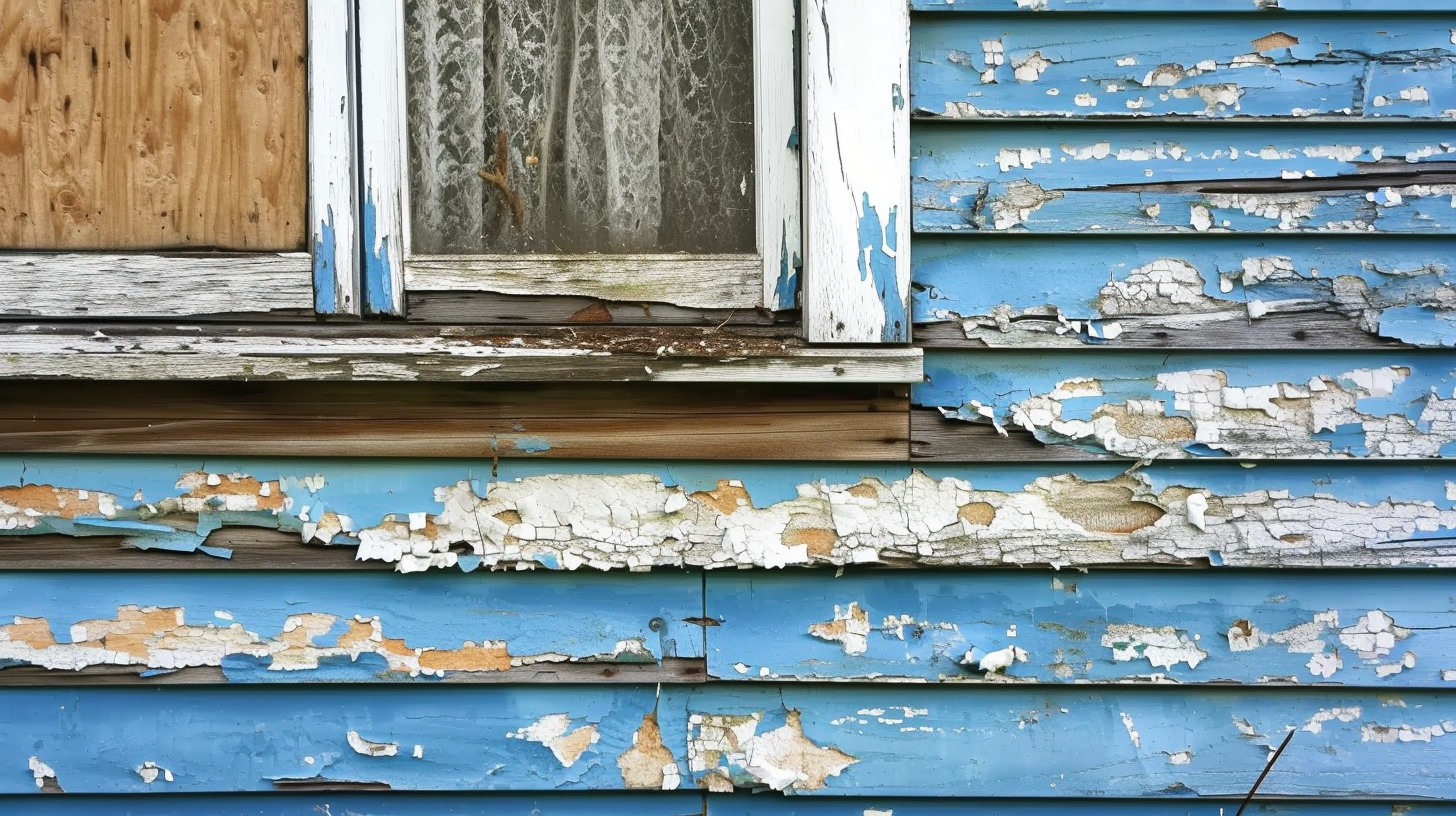Last Updated on 26th December 2023
In this informative article, we will discuss the essential steps to effectively repair damaged siding. Understanding the types of siding damage, assessing the extent of the damage, and gathering the necessary tools and materials are key initial considerations. We will then guide you through the process of preparing the siding for repair, filling cracks and holes, and ultimately repairing or replacing damaged siding panels. Additionally, we will offer valuable tips for painting, finishing, and preventing future siding damage.
Understanding the Types of Siding Damage
In order to effectively repair damaged siding, it is crucial to have a comprehensive understanding of the various types of siding damage that can occur. Common causes of siding damage include severe weather conditions like hail, wind, and heavy rain, as well as improper installation, age, and lack of maintenance. Signs and symptoms of damaged siding can vary depending on the type of siding material used. For example, wood siding may show signs of rot, warping, or peeling paint, while vinyl siding may have cracks, fading, or loose panels. Other types of siding damage can include dents, holes, and insect infestations. By identifying these common causes and recognizing the signs and symptoms of siding damage, homeowners can take the necessary steps to repair and maintain their siding effectively.
Assessing the Extent of the Damage
To accurately estimate the cost of repairs, it is essential to assess the extent of the damage to the siding, including the number of cracks, dents, and loose panels. Assessing the damage allows homeowners to determine the repair options available to them. By thoroughly examining the siding, homeowners can identify the areas that require immediate attention and prioritize the repairs accordingly. This assessment process also helps in determining whether the damaged siding can be repaired or if it needs to be replaced entirely. Additionally, by assessing the damage, homeowners can gather the necessary information to provide accurate estimates to potential contractors or insurance companies. It is important to note that assessing the damage should be done by a professional or experienced individual to ensure an accurate evaluation and appropriate repair plan.
Gathering the Necessary Tools and Materials
Regularly checking local hardware stores and online suppliers for availability, homeowners can efficiently gather the necessary tools and materials for repairing damaged siding. When it comes to choosing the right materials, it is important to consider the type of siding and the extent of the damage. Vinyl, wood, and fiber cement are common siding materials, each with their own advantages and disadvantages. Homeowners should select the material that best matches the existing siding and provides durability and weather resistance. Additionally, safety precautions during the repair process are crucial. It is recommended to wear protective gear such as gloves, safety goggles, and a dust mask to prevent injuries and exposure to harmful substances. Furthermore, using sturdy ladders and following proper ladder safety guidelines can help prevent falls and accidents during the repair process.
Preparing the Siding for Repair
Before proceeding with the repair, homeowners should carefully assess the extent of the damage and, if necessary, remove any loose or damaged pieces of siding. Once the damaged area is cleared, the next step is to prepare the siding for repair. This involves sanding and cleaning the surface to ensure a smooth and even finish. Sanding helps remove any rough edges or imperfections, allowing for better adhesion of the new siding material. After sanding, it is important to thoroughly clean the area to remove any dirt or debris. Once the surface is clean and dry, homeowners should apply a primer to seal the area and prevent moisture from seeping in. This primer acts as a protective barrier and helps the new siding adhere properly. After priming, the siding can be repaired or replaced, ensuring the integrity and aesthetics of the home’s exterior.
Filling Cracks and Holes in the Siding
After thoroughly inspecting the siding, homeowners can use a high-quality caulk or putty to effectively fill cracks and holes, ensuring a seamless and durable repair. When it comes to patching techniques, there are a few options to consider. For smaller cracks and holes, a quick and easy solution is to use a caulk gun to apply a silicone-based caulk. This will not only fill the gaps but also provide a waterproof seal. For larger holes, homeowners may need to use a putty knife to apply a vinyl spackling compound or an epoxy-based filler. These products are designed to adhere to the siding and can be sanded down to create a smooth surface. To enhance the durability of the repair, homeowners can also consider applying a waterproofing sealant over the patched areas. This will help to prevent any future water damage and prolong the lifespan of the siding. By using these patching techniques and waterproofing methods, homeowners can effectively repair damaged siding and maintain the integrity of their home’s exterior.
Repairing or Replacing Damaged Siding Panels
While repairing damaged siding panels is often a cost-effective solution, homeowners may need to consider replacing them if the damage is extensive or if the panels are beyond repair. It is important for homeowners to be aware of the various repairing techniques available to fix damaged siding panels. Some common causes of damaged siding include weather exposure, moisture infiltration, impact damage, and improper installation. When repairing damaged siding panels, it is crucial to identify the underlying cause of the damage and address it accordingly. This may involve replacing individual panels, applying patching compounds, or using specialized repair kits. Hiring a professional siding contractor can ensure that the repair is done correctly and that the siding panels are restored to their original condition, providing long-term durability and protection for the home.
Painting and Finishing the Repaired Siding
To ensure a polished and cohesive appearance, it is essential to regularly and diligently maintain the repaired siding by painting and finishing it with high-quality materials. Repainting techniques play a crucial role in achieving a long-lasting and visually appealing finish. When it comes to choosing the right paint, several factors need to be considered. Firstly, the type of siding material should be taken into account, as different materials may require different types of paint. It is also important to select a paint that is specifically designed for exterior use, as it will be more durable and resistant to weathering. Additionally, considering the color and finish of the paint is crucial in achieving the desired aesthetic. By carefully selecting the appropriate paint and utilizing effective repainting techniques, the repaired siding can be transformed into a beautiful and durable exterior surface.
Preventing Future Siding Damage
In order to effectively prevent future siding damage, it is crucial to regularly inspect and maintain the exterior of the property, paying close attention to any signs of wear and tear or potential vulnerabilities. By implementing proper maintenance tips, homeowners can prolong the lifespan of their siding and avoid costly repairs in the future. One important tip is to regularly clean the siding using mild soap and water, removing any dirt or debris that can lead to discoloration or damage. Additionally, it is essential to trim any nearby trees or shrubs that may brush against the siding, as this can cause scratches and abrasions. Inspecting the caulking and sealant around windows and doors is also important, as any gaps or cracks can allow water to seep behind the siding, leading to rot and mold growth. By following these maintenance tips, homeowners can effectively prevent future siding damage and ensure the longevity of their property’s exterior.
Hiring a Professional for Complex Siding Repairs
When it comes to complex siding repairs, hiring a professional is essential. Their expertise allows them to accurately assess the damage and determine the best course of action. Not only will this save you time and effort, but it can also be cost-effective in the long run.
Expertise for Complex Repairs
Three years of experience and specialized knowledge are essential when hiring a professional for complex siding repairs. Complex repair techniques, specialized tools, and materials are required to effectively restore damaged siding. These repairs often involve intricate procedures such as replacing damaged panels, addressing structural issues, and matching the existing siding to ensure a seamless finish. Professionals with extensive experience understand the intricacies of these techniques and can navigate any challenges that may arise during the repair process. They possess the necessary skills to use specialized tools and materials, ensuring that the repair work is done to the highest standard. By hiring a professional with the expertise for complex repairs, homeowners can have peace of mind knowing that their siding will be restored correctly and efficiently.
Time and Cost-Saving
Hiring a professional for complex siding repairs can save homeowners both time and money. When it comes to repairing damaged siding, time-saving techniques and cost-effective solutions are crucial. Professionals have the expertise and experience to quickly assess the extent of the damage and determine the most efficient repair method. They are skilled in using time-saving techniques such as advanced tools and equipment, which allows them to complete the repairs in a timely manner. Additionally, professionals have access to high-quality materials at discounted prices, reducing the overall cost of the repair. By hiring a professional, homeowners can avoid the hassle of attempting to repair the siding themselves and can have peace of mind knowing that the job will be done efficiently and effectively.




